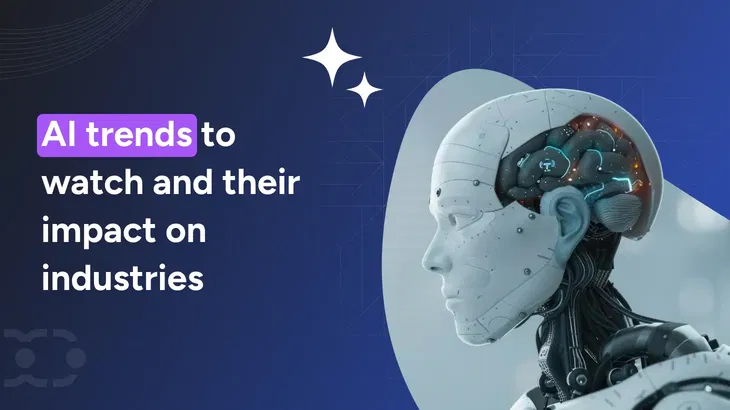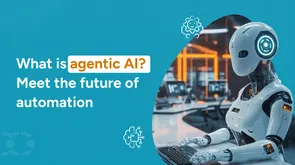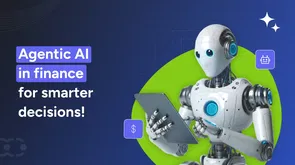We've officially entered the second half of 2025, and if there's one truth the world agrees on, it's this:
2025 is the year of AI. We are witnessing that artificial intelligence is influencing nearly every aspect of life.
The conversation has evolved from 'Will AI replace humans?' to 'How fast can we adopt current AI trends before we're left behind?'
According to the 2025 AI index report:
- 78% of organizations are now using AI, up from just 55% in the past year.
- The U.S. invested over $109 billion in private AI initiatives, nearly 12x that of China.
- The FDA approved 223 AI-enabled medical devices, up from only six in 2015.
- And AI performance on key benchmarks jumped by up to 67.3 percentage points in just one year.
In this post, you'll discover the top AI trends to watch in 2025, where the biggest shifts are happening, and how you can stay ahead.
9 Key trends shaping AI that you must watch in 2025
We're witnessing a shift from experimental adoption to embedded intelligence that's reshaping everyday life from how we work and shop to how we learn and connect.
As we move ahead in 2025, the latest trends in AI are transforming industries, automating tasks, and enabling smarter decision-making.
Here are some of the hot AI industry trends for 2025:
1. Autonomous AI systems driving decision-making
AI technology trends 2025, such as breakthroughs from world labs like DeepMind, OpenAI, and Anthropic, are pushing agentic systems beyond prototypes and into production. For broader context, this research-driven summary of AI adoption benchmarks compiles market size, investment, and adoption figures across sectors.
Around 29% of companies are already using agentic AI, and 44% plan to adopt it within the next year, showcasing its growing adoption.
Real-world use cases:
- AI-powered customer support automation: AI agents now manage entire support interactions. They utilize historical context, learn from each case, and escalate only when necessary. This enables 24/7 support without bloating headcount.
- Autonomous vehicles: These systems evaluate traffic, predict hazards, and navigate complex routes, all with minimal human intervention. Fully autonomous driving could reach 10% of all vehicles on the road by 2025.
Additionally, agentic AI is starting to handle more complex tasks such as supply chain optimization, fraud detection, and marketing campaign management. These agents operate like self-directed operators, powered by real-time data and reinforcement learning.
Insightful read: Agentic AI vs Generative AI: Which one fits your needs?
2. Generative AI embedded everywhere
Among the emerging AI trends in 2025, generative AI stands out for its significant potential, spanning content generation, workflow automation, and the reshaping of entire industries.
In 2025, Generative AI is baked directly into the platforms we use every day, from office suites and messaging apps to design tools and code editors.
Deloitte expects that 25% of companies using generative AI will pilot agentic systems in 2025.
Marketers can produce high-quality content more efficiently, personalize it at scale, and deliver measurable business value through consistent messaging and reduced time-to-market. Marketers should keep in mind that an AI writing detector offers an easy checkpoint for spotting overly mechanical phrasing, helping ensure the final content feels polished.
Real-world use cases:
- Automated code generation: Generative AI speeds up development by suggesting code, fixing bugs, and adding features with less manual work. Junior developers receive real-time guidance, while senior teams streamline repetitive tasks and ship faster.
- Seamless workflow integration: Whether you're analyzing financial data, preparing a presentation, or responding to customer tickets, generative AI is quietly working behind the scenes. It's transforming how we draft, design, and decide, without ever leaving the app.
As adoption grows, the teams that embed GenAI into their daily processes will be the biggest winners. They'll automate repetitive tasks, reduce grunt work, boost creativity, and outpace competitors still stuck in manual mode.
Teams using GenAI and AI workflow automation are already reporting significant productivity gains, allowing them to automate mundane tasks and free up time for more strategic activities.
3. Enhanced reasoning, memory, and context
Artificial intelligence is no longer just reactive; it is now proactive.
New deep learning models are demonstrating significant improvements in reasoning tasks, including math, science, and logic.
These systems can now analyze complex inputs, break them down step by step, and provide more accurate results. Faster processing speeds and lower latency are making these capabilities accessible in real-time applications.
AI is also gaining long-term memory. Instead of starting from scratch in every session, virtual assistants and customer support bots can now recall user preferences, past requests, and prior issues. This makes interactions more coherent and personalized.
Real-world use cases
- AI in customer service trends: AI can handle multi-step conversations, remember previous interactions, and offer tailored support based on context.
- AI in healthcare trends: AI tools can reference a patient's entire medical history, including test results and prescriptions, to assist in accurate diagnosis and treatment planning.
- Legal services AI trends: AI can analyze legal documents, past case files, and court rulings to recommend strategic actions in ongoing cases.
These capabilities mark the evolution from basic automation to advanced AI, capable of context-aware reasoning, memory recall, and complex problem-solving across domains.
As AI research trends in 2025 evolve, most models are becoming increasingly capable of understanding and reasoning over long-term interactions.
4. Multimodal AI bridging text, vision, and audio
Multimodal AI is particularly effective in extracting insights from unstructured data, such as images, voice notes, and handwritten documents, types of inputs that were previously difficult to analyze.
Multimodal AI can process and combine different types of inputs, such as understanding a photo, reading accompanying text, and interpreting voice tone, all at once.
It can also generate outputs like reports, spoken explanations, or visual summaries, making interactions more dynamic and human-like.
Capabilities like text-to-speech, visual analysis, and image generation are now converging, enabling more immersive and accessible experiences.
Real-world applications
- Healthcare imaging: Multimodal AI can analyze X-rays or MRIs alongside doctors' notes, lab results, and wearable data, resulting in richer, more accurate diagnoses and treatment recommendations.
- Retail & eCommerce: An AI assistant could interpret a customer's spoken request, visually match product images, and guide them through purchases with voice responses, all in a single, fluid experience.
- Security & surveillance: Systems can monitor real-time camera feeds, detect anomalies in audio patterns, and flag issues, all in context, boosting both speed and accuracy. Organizations now bring AI-driven analytics to business security cameras - spotting movement patterns, flagging unusual behavior, and sending real-time alerts to protect assets and improve safety without extra staff.
Multimodal AI is the next frontier of human-like interaction, bridging text, vision, and audio to deliver richer, more intuitive experiences.
Insightful read: How to build AI agents from scratch in 2025 (Step-by-step guide).
5. Low-code/no-code platforms enabling AI innovation
Low-code and no-code platforms are making AI accessible to everyone, from small business owners to educators and operations teams. These tools eliminate the need for coding, enabling users to build chatbots, recommendation engines, and analytics workflows quickly.
With built-in features like predictive modeling and sentiment analysis, teams can move from idea to execution in days, not months, saving both time and development costs. By putting AI in the hands of non-technical users, these platforms are accelerating innovation across industries.
Real-world use cases
- Small businesses: A local retailer can launch a product recommendation engine or automate customer support using a low-code platform. No developers needed, just business logic and a clear goal.
- Educational institutions: They can utilize artificial intelligence to personalize learning, automate grading, and track student progress. Schools can develop tools that adapt to each learner's pace, thereby enhancing engagement and improving outcomes.
From startups to large enterprises, more organizations can now experiment, build, and scale AI solutions without the traditional complexity or cost.
6. Responsible and customizable AI governance
Responsible model development now includes fairness audits, data documentation, and bias mitigation during the training process.
Forward-thinking companies are implementing internal frameworks that ensure fairness, accountability, and transparency from the ground up.
The chart below highlights how risk and data governance are centralized, emphasizing the importance of responsible AI frameworks:
Responsible AI governance is becoming increasingly important, a discipline that separates reactive teams from intentional innovators.
What responsible governance looks like:
- Built-in data privacy controls: AI systems now offer customizable options to align with internal privacy standards and user expectations.
- Bias detection and mitigation: Tools continuously monitor outputs for signs of discrimination or unfair treatment.
- Risk configuration: Teams can adjust AI behavior based on use case sensitivity, such as in financial lending or healthcare triage.
This type of governance fosters internal resilience and public trust. Companies that proactively audit, document, and refine their AI systems will reduce reputational risk and scale more confidently across various industries.
Must read: AI accountability: A business imperative for 2025.
7. Resource-efficient & sustainable AI infrastructure
As AI continues to scale in 2025, so does its energy demand.
Without action, the environmental cost of training and running AI models could become unsustainable. That's why the focus is shifting to greener infrastructure, systems built to deliver performance without compromising the planet.
Global data center energy use is climbing fast, with AI workloads expected to double electricity demand in the coming years.
Beyond energy, AI infrastructure also consumes significant water resources for cooling. This makes sustainability not just an environmental issue but a business imperative.
By optimizing energy usage and training strategies, companies are improving sustainability without compromising model performance.
To address this, companies are prioritizing three areas of innovation:
- Green power sources: Tech companies are utilizing renewable energy sources such as solar, hydro, and new nuclear solutions for their data centers, aiming for carbon neutrality and lower emissions as demand increases.
- Advanced cooling systems: Techniques such as liquid cooling and free-air cooling are reducing power consumption and water usage while maintaining server stability and safety.
- Smarter energy management: AI helps optimize energy use by scheduling tasks when cleaner energy is available, reducing the carbon footprint with real-time adjustments.
Building with efficiency in mind protects brand reputation, lowers operational costs, and helps future-proof AI development. It also ensures that innovation doesn't come at the expense of the environment.
As AI business trends in 2025 evolve, sustainability is becoming a key differentiator, with companies focusing on green power sources and innovative energy management systems.
8. Rise of small, specialized models
While large language models (LLMs) will continue to evolve, there will be a growing demand for smaller, specialized models designed for specific tasks. These smaller models can run on devices with limited computational resources, such as smartphones and IoT devices.
Use case:
- Edge computing: AI will be deployed on edge devices, such as smartphones, wearables, and smart home devices, to process data locally for real-time decision-making. For example, AI in a fitness tracker can analyze your health data in real-time, offering personalized insights without requiring cloud processing.
- Smart cities: In smart cities, small AI models will manage traffic, monitor air quality, and optimize energy usage on a local level, providing immediate responses to environmental factors.
These small, specialized models will make AI more accessible, cost-effective, and efficient, particularly for businesses that require AI capabilities without the need for large-scale computational infrastructure.
Alongside open-source innovations, many closed models are being fine-tuned for niche use cases, offering greater control over data and model behavior.
While large foundation models will remain influential, the shift toward domain-specific, optimized solutions means the top AI models in 2025 may be compact, task-specific, and designed for real-time decision-making.
9. Evolving AI regulations ensuring safe deployment
As we observe the evolution of AI market trends, governments are quickly implementing guardrails, and companies must adapt or risk falling behind.
New policies are emerging to address a range of issues, from algorithmic transparency to biometric data protection.
The European Union's AI Act is setting the tone with strict requirements for high-risk applications, while countries such as the U.S., India, and Canada are developing their frameworks.
At the same time, international cooperation is growing, with more than 50 nations signing onto global AI treaties.
What evolving regulation looks like:
- National and regional laws: From the EU to U.S. states, new mandates are targeting facial recognition, AI-generated media, and automated decision systems.
- Compliance automation: Organizations are deploying AI to track policy changes, flag risks, and auto-update internal practices.
- Public-private investment in AI education: Governments are funding training programs to ensure workers can safely build and interact with AI systems.
These regulatory moves aim to strike a balance between innovation and protection, establishing a shared baseline for the safe, trustworthy, and ethical use of AI across various sectors.
Explore more: 14 Best B2B AI automation trends to watch in 2025.
What's the next big trend after AI?
While today's frontier models push the boundaries of scale and capability, the shift to smaller, purpose-built AI systems is creating more efficient solutions for real-world problems.
AI leaders who treat it as a strategic foundation, not just a feature, will define the next decade.
Here's the future of AI trends 2025
- Quantum computing is unlocking real breakthroughs: Quantum machines have solved complex problems, such as protein folding, in hours. Microsoft and IonQ are already building hardware that can scale to millions of qubits.
- AGI (Artificial General Intelligence) is closer than most think: OpenAI's latest models are hitting 87.5% on AGI benchmarks. DeepMind predicts AGI by 2030. The shift from narrow AI to human-level reasoning is in motion.
- Neurosymbolic AI is increasing accuracy while reducing model size: SAP improved accuracy from 80% to 99.8% using neurosymbolic technology. Georgia Tech built a chip that solves advanced math problems with far fewer parameters.
- Brain-computer interfaces (BCIs) are already in clinical trials: ALS patients (Amyotrophic Lateral Sclerosis) are using BCIs to control computers with their thoughts. Over 25 trials are running today, proving this is more than science fiction.
Wrap up
As we look ahead to the future of AI trends in 2025, it is not just about smart tools; the trajectory is about a smarter ecosystem.
Beyond the top leading AI companies, forward-thinking businesses are gaining a competitive edge. However, scaling these AI systems safely will require a robust foundation in data, ethics, and organizational readiness.
Business leaders who understand both the risks and opportunities of AI will shape how these tools are integrated at scale.







Key takeaways
We've officially entered the second half of 2025, and if there's one truth the world agrees on, it's this:
2025 is the year of AI. We are witnessing that artificial intelligence is influencing nearly every aspect of life.
The conversation has evolved from 'Will AI replace humans?' to 'How fast can we adopt current AI trends before we're left behind?'
According to the 2025 AI index report:
In this post, you'll discover the top AI trends to watch in 2025, where the biggest shifts are happening, and how you can stay ahead.
9 Key trends shaping AI that you must watch in 2025
We're witnessing a shift from experimental adoption to embedded intelligence that's reshaping everyday life from how we work and shop to how we learn and connect.
As we move ahead in 2025, the latest trends in AI are transforming industries, automating tasks, and enabling smarter decision-making.
Here are some of the hot AI industry trends for 2025:
1. Autonomous AI systems driving decision-making
AI technology trends 2025, such as breakthroughs from world labs like DeepMind, OpenAI, and Anthropic, are pushing agentic systems beyond prototypes and into production. For broader context, this research-driven summary of AI adoption benchmarks compiles market size, investment, and adoption figures across sectors.
Around 29% of companies are already using agentic AI, and 44% plan to adopt it within the next year, showcasing its growing adoption.
Real-world use cases:
Additionally, agentic AI is starting to handle more complex tasks such as supply chain optimization, fraud detection, and marketing campaign management. These agents operate like self-directed operators, powered by real-time data and reinforcement learning.
2. Generative AI embedded everywhere
Among the emerging AI trends in 2025, generative AI stands out for its significant potential, spanning content generation, workflow automation, and the reshaping of entire industries.
In 2025, Generative AI is baked directly into the platforms we use every day, from office suites and messaging apps to design tools and code editors.
Deloitte expects that 25% of companies using generative AI will pilot agentic systems in 2025.
Marketers can produce high-quality content more efficiently, personalize it at scale, and deliver measurable business value through consistent messaging and reduced time-to-market. Marketers should keep in mind that an AI writing detector offers an easy checkpoint for spotting overly mechanical phrasing, helping ensure the final content feels polished.
Real-world use cases:
As adoption grows, the teams that embed GenAI into their daily processes will be the biggest winners. They'll automate repetitive tasks, reduce grunt work, boost creativity, and outpace competitors still stuck in manual mode.
Teams using GenAI and AI workflow automation are already reporting significant productivity gains, allowing them to automate mundane tasks and free up time for more strategic activities.
3. Enhanced reasoning, memory, and context
Artificial intelligence is no longer just reactive; it is now proactive.
New deep learning models are demonstrating significant improvements in reasoning tasks, including math, science, and logic.
These systems can now analyze complex inputs, break them down step by step, and provide more accurate results. Faster processing speeds and lower latency are making these capabilities accessible in real-time applications.
AI is also gaining long-term memory. Instead of starting from scratch in every session, virtual assistants and customer support bots can now recall user preferences, past requests, and prior issues. This makes interactions more coherent and personalized.
Real-world use cases
These capabilities mark the evolution from basic automation to advanced AI, capable of context-aware reasoning, memory recall, and complex problem-solving across domains.
As AI research trends in 2025 evolve, most models are becoming increasingly capable of understanding and reasoning over long-term interactions.
4. Multimodal AI bridging text, vision, and audio
Multimodal AI is particularly effective in extracting insights from unstructured data, such as images, voice notes, and handwritten documents, types of inputs that were previously difficult to analyze.
Multimodal AI can process and combine different types of inputs, such as understanding a photo, reading accompanying text, and interpreting voice tone, all at once.
It can also generate outputs like reports, spoken explanations, or visual summaries, making interactions more dynamic and human-like.
Capabilities like text-to-speech, visual analysis, and image generation are now converging, enabling more immersive and accessible experiences.
Real-world applications
Multimodal AI is the next frontier of human-like interaction, bridging text, vision, and audio to deliver richer, more intuitive experiences.
5. Low-code/no-code platforms enabling AI innovation
Low-code and no-code platforms are making AI accessible to everyone, from small business owners to educators and operations teams. These tools eliminate the need for coding, enabling users to build chatbots, recommendation engines, and analytics workflows quickly.
With built-in features like predictive modeling and sentiment analysis, teams can move from idea to execution in days, not months, saving both time and development costs. By putting AI in the hands of non-technical users, these platforms are accelerating innovation across industries.
Real-world use cases
From startups to large enterprises, more organizations can now experiment, build, and scale AI solutions without the traditional complexity or cost.
Never forget a conversation again
Salesmate's AI Employee captures, summarizes, and analyzes every call so your team can sell smarter, not harder.
6. Responsible and customizable AI governance
Responsible model development now includes fairness audits, data documentation, and bias mitigation during the training process.
Forward-thinking companies are implementing internal frameworks that ensure fairness, accountability, and transparency from the ground up.
The chart below highlights how risk and data governance are centralized, emphasizing the importance of responsible AI frameworks:
Responsible AI governance is becoming increasingly important, a discipline that separates reactive teams from intentional innovators.
What responsible governance looks like:
This type of governance fosters internal resilience and public trust. Companies that proactively audit, document, and refine their AI systems will reduce reputational risk and scale more confidently across various industries.
7. Resource-efficient & sustainable AI infrastructure
As AI continues to scale in 2025, so does its energy demand.
Without action, the environmental cost of training and running AI models could become unsustainable. That's why the focus is shifting to greener infrastructure, systems built to deliver performance without compromising the planet.
Global data center energy use is climbing fast, with AI workloads expected to double electricity demand in the coming years.
Beyond energy, AI infrastructure also consumes significant water resources for cooling. This makes sustainability not just an environmental issue but a business imperative.
By optimizing energy usage and training strategies, companies are improving sustainability without compromising model performance.
To address this, companies are prioritizing three areas of innovation:
Building with efficiency in mind protects brand reputation, lowers operational costs, and helps future-proof AI development. It also ensures that innovation doesn't come at the expense of the environment.
As AI business trends in 2025 evolve, sustainability is becoming a key differentiator, with companies focusing on green power sources and innovative energy management systems.
8. Rise of small, specialized models
While large language models (LLMs) will continue to evolve, there will be a growing demand for smaller, specialized models designed for specific tasks. These smaller models can run on devices with limited computational resources, such as smartphones and IoT devices.
Use case:
These small, specialized models will make AI more accessible, cost-effective, and efficient, particularly for businesses that require AI capabilities without the need for large-scale computational infrastructure.
Alongside open-source innovations, many closed models are being fine-tuned for niche use cases, offering greater control over data and model behavior.
While large foundation models will remain influential, the shift toward domain-specific, optimized solutions means the top AI models in 2025 may be compact, task-specific, and designed for real-time decision-making.
9. Evolving AI regulations ensuring safe deployment
As we observe the evolution of AI market trends, governments are quickly implementing guardrails, and companies must adapt or risk falling behind.
New policies are emerging to address a range of issues, from algorithmic transparency to biometric data protection.
The European Union's AI Act is setting the tone with strict requirements for high-risk applications, while countries such as the U.S., India, and Canada are developing their frameworks.
At the same time, international cooperation is growing, with more than 50 nations signing onto global AI treaties.
What evolving regulation looks like:
These regulatory moves aim to strike a balance between innovation and protection, establishing a shared baseline for the safe, trustworthy, and ethical use of AI across various sectors.
What's the next big trend after AI?
While today's frontier models push the boundaries of scale and capability, the shift to smaller, purpose-built AI systems is creating more efficient solutions for real-world problems.
AI leaders who treat it as a strategic foundation, not just a feature, will define the next decade.
Here's the future of AI trends 2025
Grow revenue, not just manage deals
Salesmate unifies sales, marketing, and support in one AI-powered platform designed to scale with you.
Wrap up
As we look ahead to the future of AI trends in 2025, it is not just about smart tools; the trajectory is about a smarter ecosystem.
Beyond the top leading AI companies, forward-thinking businesses are gaining a competitive edge. However, scaling these AI systems safely will require a robust foundation in data, ethics, and organizational readiness.
Business leaders who understand both the risks and opportunities of AI will shape how these tools are integrated at scale.
Frequently asked questions
1. How does AI predict trends?
AI predicts trends by analyzing vast amounts of data, identifying patterns, and making predictions based on historical and real-time information. Machine learning models extrapolate future trends to help businesses make informed decisions.
2. How is AI improving decision-making in various industries?
AI enhances decision-making by providing real-time insights, predictive analytics, and advanced reasoning, enabling businesses in healthcare, finance, and manufacturing to solve complex problems more efficiently.
3. What are the key benefits of low-code/no-code AI platforms?
Low-code/no-code platforms enable non-technical users to develop AI applications without requiring coding expertise, making AI more accessible and accelerating innovation in small businesses and the educational sector.
4. What are the big 5 AI ideas?
The five trends or big AI ideas include:
Agentic AI (autonomous, goal-oriented systems)
Generative AI (content creation and automation)
Multimodal AI (integration of text, vision, and audio)
AI for sustainability (green technologies and resource optimization)
AI in Automation (revolutionizing industries with smarter operations)
5. What are the key AI marketing trends in 2025?
Here are some 2025 AI trends in marketing:
Hyper-personalization through AI-powered customer insights.
Predictive analytics for forecasting consumer behavior.
Automation of routine tasks, including content creation and customer support.
Generative AI enables efficient content creation at scale.
6. What are the AI investment trends in 2025?
Here are some key AI investment trends 2025:
Continued growth in funding for AI research and development.
Major investments in generative AI and autonomous systems.
Focus on sustainability with energy-efficient AI solutions.
Increased funding for AI startups across various sectors.
Sonali Negi
Content WriterSonali is a writer born out of her utmost passion for writing. She is working with a passionate team of content creators at Salesmate. She enjoys learning about new ideas in marketing and sales. She is an optimistic girl and endeavors to bring the best out of every situation. In her free time, she loves to introspect and observe people.